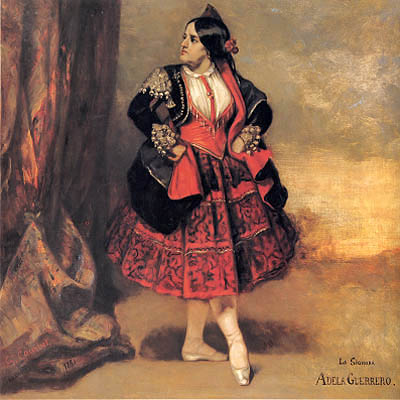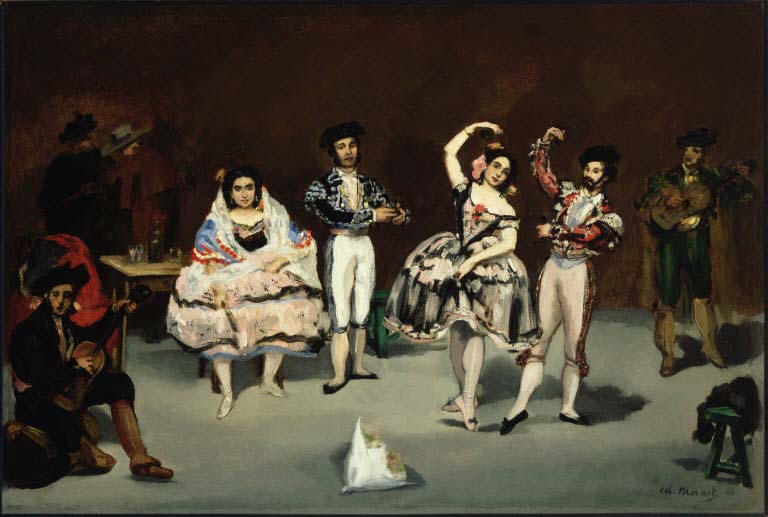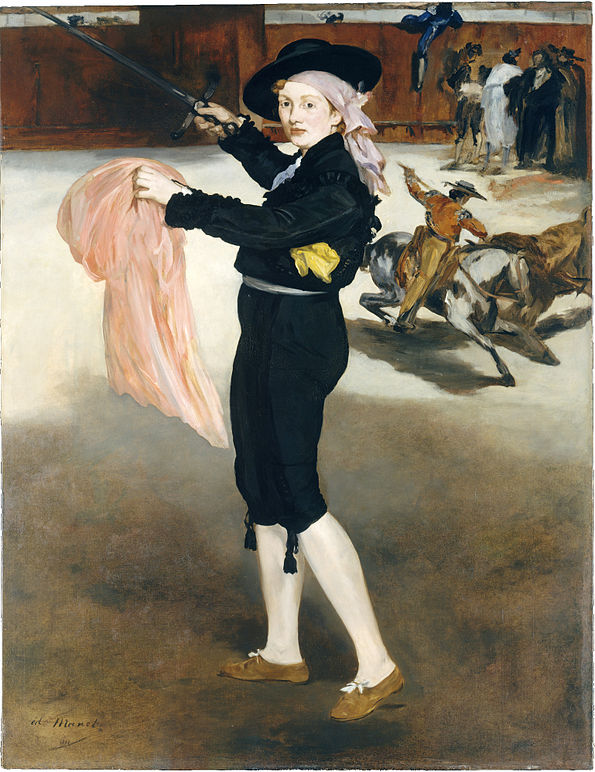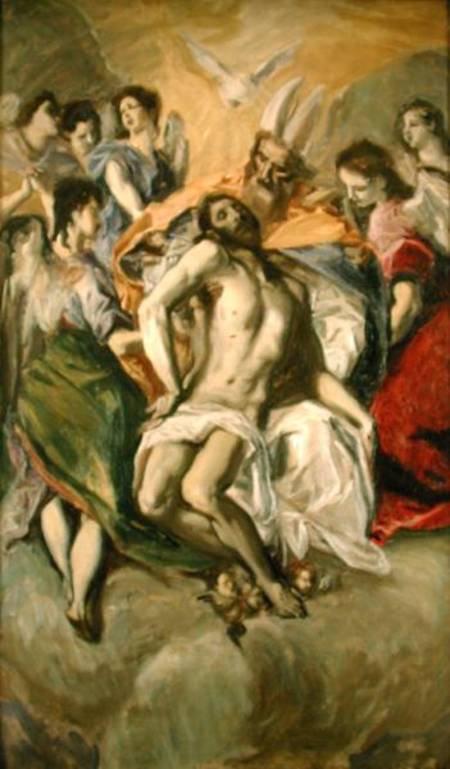The first major exhibition ever to examine the impact of 17th-century Spanish painting on 19th-century French artists, March 4–June 29, 2003 at the Metropolitan Museum of Art, featured nearly 240 paintings and works on paper spanning several centuries of European art at the most astounding levels of achievement.
On view were some 130 paintings by Velázquez, Murillo, Ribera, El Greco, Zurbarán, and other masters of Spain's Golden Age as well as masterpieces by the 19th-century French artists they influenced, among them Delacroix, Courbet, Millet, Degas, and, most notably, Manet. On view at The Metropolitan Museum of Art from March 4 through June 8, 2003, Manet/Velázquez: The French Taste for Spanish Painting also included works by American artists such as Sargent, Chase, Eakins, Whistler, and Cassatt, who studied in France but learned to paint like Spaniards.
As the title indicates, at the core of the exhibition was the "Spanish" work of Edouard Manet, whose career thoroughly reveals the importance of Spanish painting by the middle of the 19th century. Manet/Velázquez featured more paintings by Manet (more than 30) and Velázquez (14 autograph or attributed) than any American exhibitions since their eponymous retrospectives at the Metropolitan Museum more than a decade ago.
The exhibition was organized by The Metropolitan Museum of Art and the Réunion des Musées Nationaux/Musée d'Orsay.
Manet/Velázquez: The French Taste for Spanish Painting offered an extraordinarily rich look at one of the most pivotal epochs in Western art, when French artists of the 19th century shifted their focus from the idealism of Italian Renaissance art and embraced the naturalism of Spanish Baroque painting, setting the course for many of the greatest achievements of French Realism, Impressionism, and Post-Impressionism.
Prior to the 19th century, Spanish art had been virtually ignored in France and was thus poorly represented in French collections. This changed with Napoleon's Spanish campaigns (1808–14), which marked a turning point in the French perception of Spanish painting, as the Emperor in Paris sought to obtain key works from every corner of Europe. Although these works were ultimately returned to their countries of origin, just a few decades later, in 1838, King Louis Philippe inaugurated the Galerie Espagnole at the Louvre, placing on view his extraordinary collection of hundreds of Spanish paintings. Although this collection was itself sold in 1853, these paintings left an indelible impression in France. In subsequent years, the works of the Spanish masters became increasingly familiar to Parisians as the Louvre acquired more Spanish paintings and artists traveled to Madrid to study the masterpieces at the Prado. By the 1860s, the French taste for Spanish painting was perceptible at each Paris Salon.
Manet/Velázquez featured major works – many of which had rarely been lent to exhibitions – from the Museo del Prado in Madrid, the Musée d'Orsay and Musée du Louvre in Paris, and public and private collections from across Europe and North America. Among the highlights were

Velázquez's Count-Duke of Olivares (1622-27, Hispanic Society of America, New York)

and The Buffoon Pablo de Valladolid (ca. 1636-37, Museo del Prado),

Zurbarán's Saint Francis in Meditation (ca. 1635-40, National Gallery, London),

Ribera's The Clubfooted Boy (1642, Musée du Louvre),

Murillo's Immaculate Conception of the Venerables (1660-65, Museo del Prado),
_(Spanish_-_Bullfight,_Suerte_de_Varas_-_Google_Art_Project.jpg/585px-Francisco_Jos%C3%A9_de_Goya_y_Lucientes_(Francisco_de_Goya)_(Spanish_-_Bullfight,_Suerte_de_Varas_-_Google_Art_Project.jpg)
and Goya's Bullfight Scene: "Suerte de Varas" (1824, The J. Paul Getty Museum, Los Angeles).
Works by French artists included
Delacroix's Saint Catherine, after Zurbarén (1824, Musée des Beaux-Arts de Béziers),

Courbet's La Signora Adela Guerrero, Spanish Dancer (1851, Musées royaux des Beaux-Arts de Belgique),

Degas's Thérèse De Gas (ca. 1863, Musée d'Orsay),

and Renoir's Romaine Lacaux (1864, The Cleveland Museum of Art).
Of the more than 30 Manets in the exhibition were many of the artist's acclaimed "Spanish" pictures, including

The Spanish Ballet (1862, The Phillips Collection, Washington, D.C.),

Mlle V… in the Costume of an Espada (1862, The Metropolitan Museum of Art),
.jpg!Large.jpg)
The Dead Toreador (1864, National Gallery of Art, Washington, D.C.),

and The Balcony (1868-69, Musée d'Orsay).
American artists who went to Paris to study in the 19th century also succumbed to the allure of Spanish art, and the exhibition at the Metropolitan included
John Singer Sargent's copies after Velázquez
(Buffoon Don Juan de Austria (after Velazquez) John Singer Sargent - 1879)
and El Greco

(John Singer Sargent - The Descent from the Cross, after El Greco)
as well as such iconic images as

Dr. Pozzi at Home (1881, U.C.L.A. Hammer Museum),

The Daughters of Edward Darley Boit (1882, Museum of Fine Arts, Boston),
,_John_Singer_Sargent,_1884_(unfree_frame_crop).jpg/300px-Madame_X_(Madame_Pierre_Gautreau),_John_Singer_Sargent,_1884_(unfree_frame_crop).jpg)
and the Metropolitan's own Madame X (Madame Gautreau, née Virginie Avegno) of 1882.
Mary Cassatt, William Merritt Chase, Thomas Eakins, and James Abbott McNeill Whistler were also represented by multiple works in the exhibition.

Manet/Velázquez: The French Taste for Spanish Painting was accompanied by a fully illustrated catalogue, including essays by the organizing curators and by several notable scholars of this period. Published by The Metropolitan Museum of Art, the catalogue will be distributed by Yale University Press.
The exhibition was conceived by Gary Tinterow, Engelhard Curator of 19th-Century European Painting at the Metropolitan Museum, and organized by him with Genevieve Lacambre, Honorary Curator in Chief of the Musée d'Orsay, Paris, with the assistance of Deborah Roldán, Research Assistant in the Department of European Paintings at The Metropolitan Museum of Art.